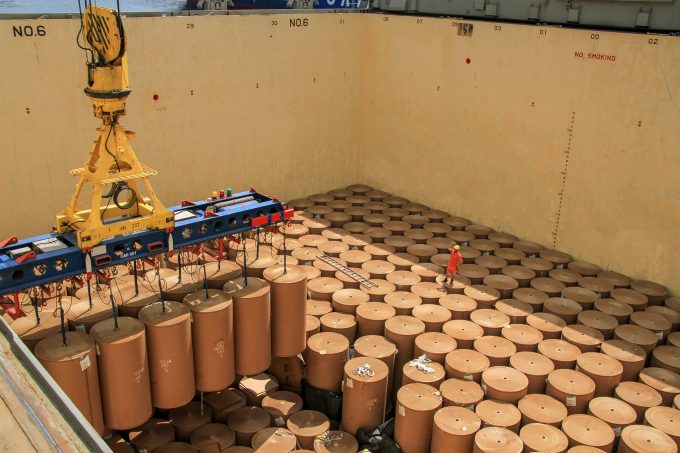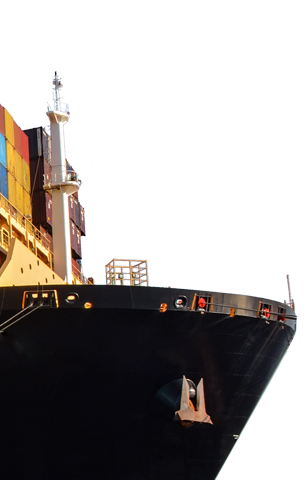Breakbulk business steady at JAXPORT
- Home
- >
- Cargo Blog
- >
- Breakbulk business steady at JAXPORT

By Sandy White
This story first appeared in the 2021 JAXPORT Magazine and has been updated to reflect Enstructure’s acquisition of Patriot Ports.
While the global pandemic has accelerated many digital innovations over the past year – traditional paper, pulp and forest products are increasingly finding efficient routes into the U.S. through JAXPORT.
“This cargo segment has a solid base in Jacksonville,” said Rick Schiappacasse, JAXPORT Director, Cargo Sales, due to the port’s efficient and skilled operators and ocean services dedicated to breakbulk.
TRENDS IN FOREST PRODUCTS
The global pandemic has had an impact on forest products.
The demand for products like airport and airline-distributed magazines and newspapers, as well as flyers for schools and brick-and-mortar retail advertising inserts, has declined with less people traveling, shopping, and going to work or attending school in person.
However, items like direct-to-consumer mail pieces and labels, whether for a product or for an ecommerce package, and home-oriented and local magazines have been increasing in demand.
Pulp has been a bright spot, says Brian Frennea, Vice President Forest Products and Logistics at SSA Marine, Inc., a terminal operator who has been handling import and export breakbulk cargo and wood pulp for decades. SSA operates on-dock warehousing space to handle pulp at JAXPORT’s Blount Island Marine Terminal.
“The pandemic actually resulted in some increased volumes of import pulp to the U.S. to fill recycled fiber supply gaps and a general increased demand for tissue products,” Frennea said.
SERVING THE INDUSTRY
“SSA targeted the import wood pulp business for Jacksonville then deployed skilled supervision and equipment resources to professionally service the business,” said Frank McBride, SSA Atlantic Vice President Florida Operations.
Ocean carrier G2 Ocean has been bringing forestry products into JAXPORT since the early 1990s, said Chartering Director Andy Powell, including rolls, fluff pulp, lumber and bleached kraft pulp in bales from Brazil. The company uses open-hatch box-shaped cargo holds and crane lifting capacity of up to 150 metric tons. “Our extensive range of vessels is tailor-made to handle various lengths and diameters of forestry products, ensuring optimal cargo care and flexibility,” he said.
G2 Ocean has seen the increased flow of Brazilian wood pulp into the United States, Powell said.
“We find the terminal expansion that JAXPORT has undertaken as critical to effectively manage the extra demand,” he said. “We need to ensure safe and efficient shipping operations. JAXPORT is putting in the resources to make this happen.”
Frennea agreed, saying, “The SSA and JAXPORT operations remained solid and effectively supported the supply chain demands, further proving its value to customers and carriers operating in the U.S. Southeast pulp market.”
For paper customers, Enstructure acts as a distribution center at JAXPORT’s Talleyrand Marine Terminal, and much of the product comes from the Baltic area of Europe on a regular schedule aboard vessels from ocean carrier Spliethoff.
Peter Gutter of the Baltic Department at Spliethoff said that the firm “offers a fast, reliable and dedicated service from Europe to the U.S. East Coast, specializing in paper reels and pulp shipped as breakbulk for many decades.”
[clickToTweet tweet=”JAXPORT does a very good job of keeping efficiencies at the gate so that trucks can get in and out quickly and in a timely manner. – Scott MacGregor, Enstructure” quote=”JAXPORT does a very good job of keeping efficiencies at the gate so that trucks can get in and out quickly and in a timely manner. – Scott MacGregor, Enstructure”]Spliethoff’s specialized vessels offer side loaders designed for efficient handling of paper rolls, which is a competitive advantage, said Enstructure’s Vice President Seaonus and Portus Terminals Scott MacGregor.
The company brings paper into its warehouses, where containers are stripped and loaded back into over-the-road trailer, intermodal/ container or boxcar.
Handling the large rolls of paper, which can sometimes measure up to 90 inches tall, requires a deft touch, MacGregor said. “It’s a very careful process from the time the rolls are produced,” he said. “Even though they weigh over four metric tons, they are very delicate.”
Jon Vander Wal, Vice President, North America Supply Chain for paper and pulp producer UPM, agrees, saying that this type of paper has very little tolerance for damage.
“Our customers and printers are under pressure to be better stewards of the paper that they’re using,” he said. “It’s important for us to have partners and operators who can handle the paper and load into vehicles and rail cars while minimizing damage and loading it, so that there isn’t further damage in the course of transit. It requires a great amount of skill.”
Partnership in ensuring this commodity’s safe transportation is key, says Gutter. “Due to a very good combination of long-term partnership with the focus on the right targets with all the expertise and knowledge we have in our teams (JAXPORT, Enstructure and Spliethoff), it has proven to be a reliable way of shipping the paper, pulp and breakbulk cargoes into and from the U.S.,” he said.
THE JAXPORT DIFFERENCE
Unloading efficiency is a bonus for JAXPORT, Schiappacasse said. “These products can be damaged by rain or weather. The proximity from berth to the warehouse is very close – 80 feet – which helps lessen the chance of moisture damage.”
The ease of access to interstates and the availability of warehouse space also make JAXPORT attractive.
Vander Wal says JAXPORT offers a “very economical way to reach a good portion of the United States.”
Direct services from two Class I rail lines—Norfolk Southern and CSX— is a benefit, MacGregor said. So is proximity to key interstate lines.
“JAXPORT does a very good job of keeping efficiencies at the gate so that trucks can get in and out quickly and in a timely manner,” MacGregor said.
Technology enhancements provided by port tenants is also helping shippers gain visibility into their freight movements. At SSA Marine, Frennea said, “We have an IT product developed for the import wood pulp trade that provides a fully integrated solution to efficiently manage the flow of information and control of its customers cargo.”
JAXPORT also offers experienced operators, Vander Wal said. “We’re competing against domestic competitors in the U.S. What JAXPORT allows us to do, with the warehousing operations being as efficient as they are, is stage inventory for our customers at the port as it arrives. This allows us to more closely emulate or even exceed the service capabilities of our competitors.”
